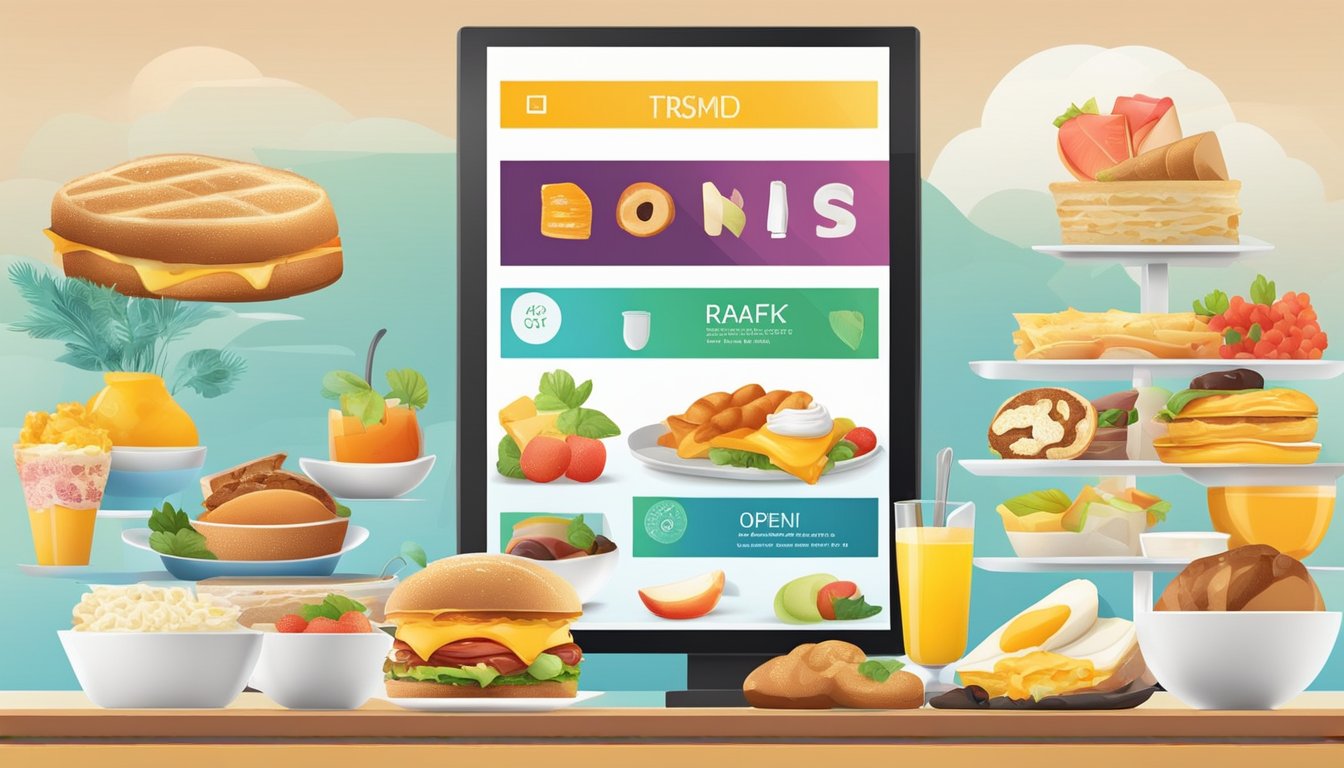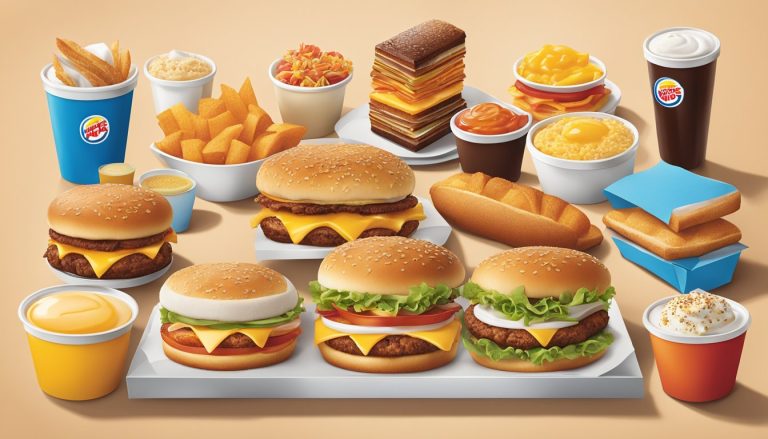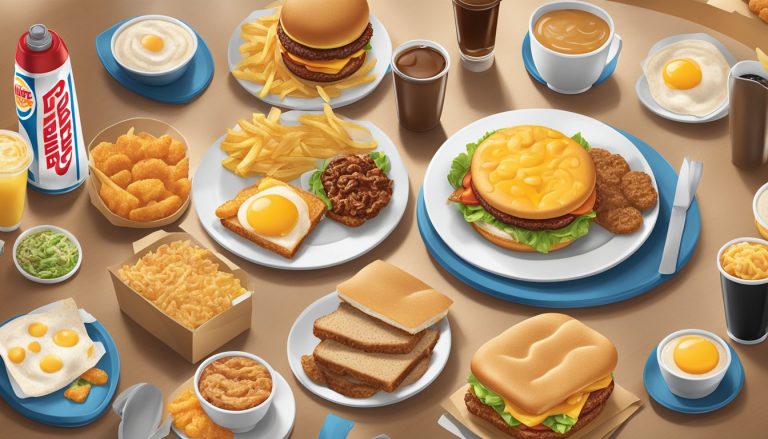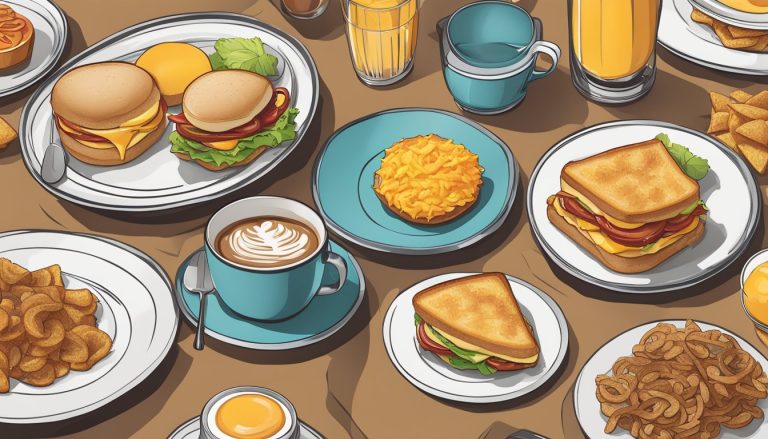Burger King’s breakfast menu design employs subtle psychological techniques to influence customer choices and boost profits. The layout, colors, and wording are carefully crafted to guide diners toward specific items and increase overall spending.
Menu engineers utilize positioning strategies, color theory, and persuasive language to subtly shape customer decisions. High-margin items are often placed in prominent positions, while appealing colors and descriptive phrases are used to make certain dishes more enticing. These tactics tap into customers’ subconscious preferences and decision-making processes.
The psychology behind BK’s breakfast menu extends beyond visual elements to pricing strategies and option presentation. By understanding how customers perceive value and make choices, Burger King aims to create a breakfast menu that satisfies diners while maximizing revenue for the restaurant.
Understanding Burger King’s Brand Identity

Burger King’s brand identity is a carefully crafted blend of visual elements and design principles. The iconic logo, color palette, and typography work together to create a recognizable and memorable brand image that resonates with customers worldwide.
Evolution of the BK Logo
The Burger King logo has undergone several transformations since the company’s inception in 1954. Initially, the logo featured a simple text-based design with a king character. In 1969, the iconic “bun halves” logo was introduced, symbolizing the brand’s signature hamburgers. This design remained largely unchanged until 1994 when a more dynamic, tilted version was adopted.
The current logo, introduced in 2021, features a minimalist design with bold, rounded letters and vibrant colors. This retro-inspired look pays homage to the brand’s heritage while appealing to modern sensibilities. The simplified design ensures better visibility across digital platforms and various marketing materials.
Role of Colour Palette and Typography in Branding
Burger King’s color palette plays a crucial role in its brand identity. The primary colors – red, yellow, and blue – evoke feelings of warmth, energy, and trustworthiness. Red stimulates appetite, yellow represents happiness and optimism, while blue adds a sense of reliability.
Typography is equally important in Burger King’s branding. The company uses a custom typeface called “Flame Sans” for its logo and marketing materials. This bold, rounded font conveys a friendly and approachable image. It’s easily readable across various mediums, from outdoor signage to mobile apps.
The combination of vibrant colors and distinctive typography creates a cohesive visual identity that helps Burger King stand out in the competitive fast-food market. These elements work together to reinforce the brand’s personality and values, making it instantly recognizable to consumers worldwide.
Sensory Appeal in Menu Design
Sensory appeal plays a crucial role in menu design, influencing customer perceptions and choices. Visual elements and descriptive language work together to create a more enticing dining experience.
The Influence of Visual Elements
Color schemes and imagery on menus can significantly impact customer decisions. Warm colors like red and orange are known to stimulate appetite, while cool tones like blue and green may suppress it. BK’s breakfast menu often incorporates vibrant yellows and oranges, evoking feelings of warmth and energy associated with morning meals.
High-quality food photography can make items appear more appetizing. BK strategically places appealing images of their breakfast sandwiches and platters to catch the eye and trigger cravings.
Typography also plays a part in visual appeal. Clear, legible fonts ensure customers can easily read menu descriptions. BK typically uses bold, sans-serif fonts for item names to make them stand out.
Taste Perception Through Menu Descriptions
Well-crafted menu descriptions can enhance taste expectations and perceived value. BK’s breakfast menu often employs vivid, sensory-rich language to describe their offerings.
Words like “fluffy,” “crispy,” and “melted” activate the senses and paint a picture of texture and taste. For example, describing an item as a “golden, crispy hash brown” rather than simply “hash brown” can make it more appealing.
Highlighting quality ingredients can also influence perceptions. BK might emphasize “100% real eggs” or “freshly baked biscuits” to convey freshness and quality.
By combining visual elements with appetizing descriptions, BK aims to create a menu that not only informs but also entices customers to try their breakfast offerings.
Psychological Tactics in Marketing
Fast food marketing employs sophisticated psychological strategies to influence consumer behavior. These tactics tap into emotions and leverage storytelling to create memorable brand experiences.
Targeting Emotions through Brand Experience
Burger King’s breakfast menu design aims to evoke positive emotions in customers. The use of warm colors like red and yellow stimulates appetite and creates a sense of urgency. Carefully selected food imagery triggers cravings and nostalgia.
Brand mascots and characters build emotional connections with consumers. The King mascot, for example, adds a playful element to BK’s marketing efforts. Social media campaigns encourage customer engagement and foster a sense of community around the brand.
Menu descriptions use sensory language to appeal to multiple senses. Words like “sizzling,” “melty,” and “fresh-cracked” paint vivid mental pictures of tasty breakfast items.
The Power of Storytelling in Fast Food Marketing
Storytelling helps Burger King create a compelling narrative around its breakfast offerings. Marketing campaigns often feature relatable scenarios or characters enjoying BK’s morning meals. These stories resonate with target audiences and make the brand more memorable.
Social media platforms serve as key channels for sharing brand stories. Short video clips, customer testimonials, and behind-the-scenes content give followers a deeper connection to the BK breakfast experience.
Limited-time promotions and seasonal menu items create a sense of urgency and exclusivity. These time-bound offerings become part of the brand’s ongoing story, encouraging repeat visits and social media sharing.
Product Packaging as a Marketing Tool
Product packaging serves as a powerful marketing tool, influencing consumer perceptions and purchase decisions. It combines functionality with aesthetics while also addressing environmental concerns.
The Functionality and Aesthetics of Packaging
Packaging design plays a crucial role in product protection and branding. Effective packaging ensures product safety during transport and storage. It also communicates key information about the product to consumers.
Visual elements like colors, shapes, and typography create instant brand recognition. For example, Burger King’s breakfast menu packaging often features warm, appetizing colors to evoke hunger and comfort.
Packaging quality can signal product value. Premium materials or unique designs may suggest higher quality contents. This perception can justify higher prices and increase sales.
Packaging Innovations and Environmental Considerations
Innovative packaging solutions can set products apart on crowded shelves. Smart packaging technologies, such as QR codes or augmented reality features, enhance customer engagement.
Sustainable packaging is becoming increasingly important. Brands are exploring biodegradable materials and minimalist designs to reduce waste. This approach appeals to environmentally conscious consumers.
Reusable or multi-functional packaging adds value for customers. It extends the product’s lifecycle and creates a lasting brand presence in consumers’ lives.
Packaging that clearly communicates eco-friendly attributes can influence purchase decisions. Brands showcasing their commitment to sustainability through packaging often gain consumer trust and loyalty.
Social Media’s Role in Breakfast Menu Promotion

Social media platforms serve as powerful tools for Burger King to promote its breakfast menu and engage with customers. These digital channels allow BK to create buzz around new items and interact directly with consumers.
Creating a Buzz Around New Items
Burger King leverages social media to generate excitement for breakfast menu additions. The company shares enticing photos and videos of new items across platforms like Facebook, Instagram, and Twitter. These visually appealing posts are designed to spark interest and encourage customers to try the latest offerings.
BK often uses hashtags to increase visibility and encourage user-generated content. For example, a new breakfast sandwich launch might be accompanied by a branded hashtag campaign. This strategy amplifies reach and creates a sense of community among fans.
Timed promotions and limited-time offers are frequently announced via social channels. These create a sense of urgency, prompting followers to visit restaurants before promotions end.
Engaging with Consumers on Digital Platforms
Burger King actively interacts with customers on social media, fostering a stronger brand connection. The company responds to comments and messages, addressing questions about breakfast menu items and store locations.
BK encourages customers to share their breakfast experiences using specific hashtags or by tagging the brand. This user-generated content is often reshared, providing social proof and expanding the brand’s reach organically.
Polls and surveys on platforms like Twitter allow BK to gather feedback on breakfast preferences. This data informs menu decisions and helps tailor offerings to customer tastes.
The brand also uses social media for customer service, quickly addressing concerns or issues related to breakfast orders. This responsiveness enhances the overall brand experience and builds customer loyalty.
Leveraging Technology in the Breakfast Segment

Burger King has embraced digital innovation to enhance its breakfast offerings and streamline the customer experience. Technology plays a crucial role in modernizing ordering processes and shaping consumer behavior in the morning rush.
Innovations in Ordering: Mobile and Drive-Thru
BK’s mobile app allows customers to pre-order breakfast items for quick pickup. This feature caters to time-pressed commuters seeking a convenient meal solution.
The app offers exclusive deals and personalized recommendations based on order history. These incentives aim to boost customer loyalty and increase breakfast sales.
Drive-thru lanes have been upgraded with digital menu boards. These displays adapt in real-time, showcasing popular items during peak hours and optimizing product visibility.
Voice recognition technology is being tested at select locations. This innovation promises to speed up drive-thru orders and improve accuracy during busy breakfast periods.
The Impact of Technology on Consumer Habits
Social media campaigns highlight BK’s breakfast menu, creating buzz around new items. Targeted ads on platforms like Instagram and TikTok aim to capture younger demographics.
Mobile ordering has shifted peak breakfast hours. More customers now place orders before leaving home, leading to a more evenly distributed morning rush.
Data analytics help BK refine its breakfast menu. By tracking popular combinations and time-based preferences, the chain can tailor offerings to meet demand.
Digital loyalty programs incentivize repeat visits. Points earned on breakfast purchases can be redeemed for future meals, encouraging habitual morning stops at BK.
Exploring BK’s Signature Breakfast Offerings

Burger King’s breakfast menu features iconic items that have become customer favorites. These offerings blend familiar flavors with unique twists to create memorable morning meals.
Deconstructing the Whopper’s Appeal
The Whopper, Burger King’s flagship burger, has inspired breakfast counterparts. The Croissan’wich adapts the Whopper’s layered approach, replacing the beef patty with eggs, cheese, and breakfast meats.
This sandwich mimics the Whopper’s satisfying taste and texture profile. The flaky croissant provides a buttery base, while the fillings offer a protein-rich start to the day.
BK’s breakfast menu also includes a Fully Loaded Croissan’wich. This hearty option piles on extra ingredients for those seeking a more substantial meal.
The Rise of French Toast Sticks
French Toast Sticks have emerged as a beloved Burger King breakfast staple. These portable, sweet treats cater to on-the-go diners and those with a morning sweet tooth.
The sticks feature a crispy exterior and soft, custard-like interior. They come with a side of syrup for dipping, enhancing their appeal as a handheld option.
BK has capitalized on the popularity of French Toast Sticks by offering them in various meal combinations. This flexibility allows customers to balance sweet and savory flavors in their breakfast choices.
The consistent quality and taste of these items have helped them maintain their status as breakfast menu mainstays.
Analyzing Competitive Tactics Among Fast-Food Brands
Fast-food brands employ various strategies to gain an edge in the competitive breakfast market. These tactics range from menu design to pricing and promotional efforts.
Comparative Analysis of Menu Designs
Fast-food chains carefully craft their breakfast menus to attract customers and outperform rivals. Burger King’s breakfast menu design incorporates eye-catching visuals and strategic item placement to influence customer choices.
The chain often positions high-profit items prominently, using larger fonts or special graphics to draw attention. BK may also group similar items together, making it easier for customers to compare options and choose upgrades.
Pricing strategies play a crucial role in menu design. Burger King frequently offers value meals or combo deals to entice budget-conscious consumers. These deals are typically highlighted through color or boxed sections on the menu.
Fast-food brands like BK also use descriptive language to make items more appealing. Words like “fresh,” “flame-grilled,” or “hand-crafted” can increase perceived value and encourage purchases.
Seasonal or limited-time offerings are another tactic used in menu design. These items create a sense of urgency and can drive repeat visits from customers eager to try new options before they disappear.
The Future of Fast-Food Breakfast Menus

Fast-food chains are poised to revolutionize breakfast offerings through innovative menu items and enhanced ordering experiences. These changes aim to meet evolving consumer preferences and capitalize on technological advancements.
Predicting Trends and Consumer Expectations
Fast-food brands will likely focus on expanding plant-based options to cater to health-conscious customers. Burger King’s reintroduction of an updated black bean burger signals this shift towards more diverse protein choices.
Taste will remain paramount, with chains experimenting with bold flavors. Wendy’s Hot Honey Chicken Biscuit exemplifies this trend of combining sweet and savory elements in breakfast items.
Technology will play a crucial role in shaping the future of fast-food breakfast. Mobile ordering apps and AI-powered drive-thrus will streamline the ordering process, reducing wait times and enhancing convenience.
Customization options are expected to increase, allowing customers to tailor their breakfast items to their specific preferences. This may include mix-and-match components or adjustable portion sizes.
Fast-food chains will likely invest more in breakfast-specific marketing campaigns to capture a larger share of the morning market. Wendy’s $20 million investment in its breakfast launch demonstrates the importance of this daypart.
Nutritional transparency and healthier alternatives will become more prominent on breakfast menus. Chains may offer calorie-conscious options alongside indulgent favorites to appeal to a broader customer base.




